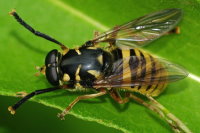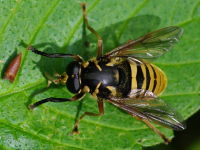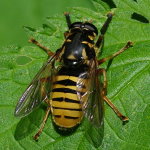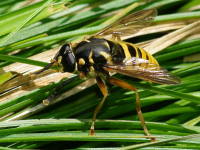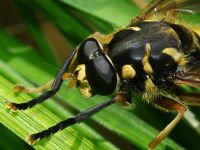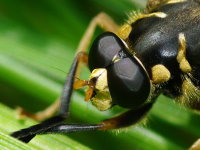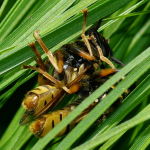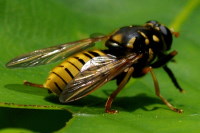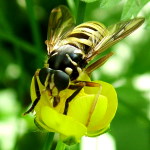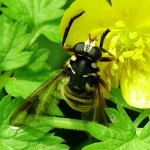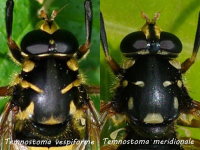Phylum Arthropoda (Arthropods) ➔ Subphylum Hexapoda (Hexapods) ➔ Class Insecta (Insects) ➔ Order Diptera (True flies) ➔ Family Syrphidae (Hoverflies)
Temnostoma vespiforme (Linnaeus, 1758)
Wespen-Moderholzschwebfliege
Synonyms and other combinations:
Milesia excentrica Harris, 1835 | Milesia excentrica Harris, 1841 | Milesia wagae Gorski, 1852 | Spilomyia sericomyiaeforme Portschinsky, 1886 | Spilomyia sibiricum Portschinsky, 1886 | Spilomyia vulgare Portschinsky, 1886 | Syrphus frequens Matsumura, 1931 | Temnostoma aequalis Loew, 1864 | Temnostoma meridionale Krivosheina & Mamaev, 1962 | Temnostoma strigosum Sack, 1941 |
Classification:
Temnostoma vespiforme belongs to the subfamily Eristalinae, tribe Milesiini.Distribution:
Palaearctic: From Western Europe to Japan; in Europe from northern Sweden to the Pyrenees and from France to the Caucasus.Habitat:
Moist deciduous forest with well-developed undergrowth and abundant dead wood.Description:
Body length 12 - 18 mm; mesoscutum with yellow marks immediately anterior to the postalar calli connected to yellow marks on the postalar calli and elongated yellow marks on each side in the vicinity of the transverse suture, crossing the transverse suture uninterrupted; abdomen: at least tergites 3 - 4 in the male and 3 - 5 in the female with two distinct, transverse, yellow bands frequently joined by a narrow yellow middle strip; the anterior and posterior bands reach the lateral margins of the tergites, which are normally entirely, and broadly, yellow.Similar species:
A similar species is Temnostoma meridionale. Both species can be distinguished by the yellow spots on the mesoscutum. For comparison, the last picture shows a male of Temnostoma vespiforme and a female of Temnostoma meridionale.Biology:
Temnostoma vespiforme flies from May to August.The species is often found near brooks and rivers. The males usually hover at a height of about 3 m. They gather on flowering shrubs and wait for females. Both sexes regularly visit flowers and are often observed on white umbellifers and flowering shrubs (hawthorn, elderberry, raspberry, red honeysuckle).
Larvae of Temnostoma vespiforme live and develop in the wet wood of dead deciduous trees and stumps. The larvae have a stocky, muscular body with hooks in the chest area. They bore burrows in the wood, which they keep open for the supply with oxygen. The wood-eating (xylophagous) larvae feed on microorganisms that live in the wood.
The development of the larvae probably takes 2 years.
Mimicry:
The striking yellow and black colored Temnostoma species not only resemble wasps in their appearance, but also mimic them with their behavior. They usually keep their forelegs extended far beyond the head so that they resemble the antennae of wasps. This mimicry helps to protect against predators, such as birds.Natural enemies:
Phaenocarpa barthii (Brues, 1907) - Hymenoptera, Braconidae.Phaenocarpa tiliae Tobias, 1986 - Hymenoptera, Braconidae.
References, further reading, links:
- Pape T. & Thompson F.C. (eds) (2017). Systema Dipterorum (version 2.0, Jan 2011). In: Species 2000 & ITIS Catalogue of Life, 2017 Annual Checklist (Roskov Y., Abucay L., Orrell T., Nicolson D., Bailly N., Kirk P.M., Bourgoin T., DeWalt R.E., Decock W., De Wever A., Nieukerken E. van, Zarucchi J., Penev L., eds.). Digital resource at www.catalogueoflife.org/annual-checklist/2017. Species 2000: Naturalis, Leiden, the Netherlands. ISSN 2405-884X.
- Gerald Bothe: Bestimmungsschlüssel für die Schwebfliegen (Diptera, Syrphidae) Deutschlands und der Niederlande, DJN, 1984, ISBN 3-923376-07-3
- M.C.D.Speight: Species Accounts of European Syrphidae (Diptera), Glasgow 2011, Syrph the Net, the database of European Syrphidae, vol. 65, 285 pp., Syrph the Net publications, Dublin.
- Menno Reemer, Willem Renema, Wouter van Steenis, Theo Zeegers, Aat Barendregt, John T. Smit, Mark P. van Veen, Jeroen van Steenis, Laurens van der Leij: De Nederlandse Zweefvliegen (Diptera: Syrphidae), Nederlandse Fauna 8, 2009.
- Speight, M.C.D. & Sarthou, J.-P. (2014) StN keys for the identification of the European species of various genera of Syrphidae (Diptera) 2014 / Clés StN pour la détermination des espèces Européennes de plusieurs genres des Syrphidae (Diptères) 2014. Syrph the Net, the database of European Syrphidae, Vol. 80, 125 pp, Syrph the Net publications, Dublin
- Anasimyia interpuncta
- Anasimyia transfuga
- Baccha elongata
- Blera fallax
- Brachyopa sp.
- Brachypalpoides lentus
- Brachypalpus laphriformis
- Brachypalpus sp.
- Brachypalpus valgus
- Ceriana conopsoides
- Ceriana vespiformis
- Chalcosyrphus femoratus
- Chalcosyrphus nemorum
- Chalcosyrphus valgus
- Cheilosia albipila
- Cheilosia albitarsis
- Cheilosia chrysocoma
- Cheilosia illustrata
- Cheilosia pagana
- Cheilosia scutellata
- Cheilosia sp.
- Cheilosia variabilis
- Chrysogaster sp.
- Chrysotoxum bicinctum
- Chrysotoxum fasciatum
- Chrysotoxum festivum
- Chrysotoxum verralli
- Criorhina berberina
- Dasysyrphus albostriatus
- Dasysyrphus sp.
- Dasysyrphus tricinctus
- Didea fasciata
- Didea intermedia
- Didea sp.
- Epistrophe diaphana
- Epistrophe eligans
- Epistrophe flava
- Epistrophe grossulariae
- Epistrophe melanostoma
- Epistrophe melanostoma/nitidicollis
- Epistrophella euchroma
- Episyrphus balteatus
- Eristalinus aeneus
- Eristalinus megacephalus
- Eristalinus taeniops
- Eristalis arbustorum
- Eristalis interrupta
- Eristalis intricaria
- Eristalis lineata
- Eristalis pertinax
- Eristalis rupium
- Eristalis similis
- Eristalis sp.
- Eristalis tenax
- Eumerus purpurariae
- Eumerus sp.
- Eupeodes corollae
- Eupeodes luniger
- Eupeodes sp.
- Eurimyia lineata
- Ferdinandea cuprea
- Hammerschmidtia ferruginea
- Helophilus hybridus
- Helophilus pendulus
- Helophilus sp.
- Helophilus trivittatus
- Ischiodon aegyptius
- Leucozona glaucia
- Leucozona laternaria
- Leucozona lucorum
- Melangyna lasiophthalma
- Melangyna quadrimaculata
- Melangyna umbellatarum
- Melanogaster sp.
- Melanostoma scalare
- Meligramma triangulifera
- Meliscaeva cinctella
- Merodon ambiguus
- Merodon avidus
- Merodon equestris
- Merodon moenium
- Merodon obscuritarsis
- Merodon sp.
- Microdon analis/major
- Microdon mutabilis/myrmicae
- Myathropa florea
- Myolepta dubia
- Orthonevra sp.
- Paragus sp.
- Parasyrphus lineolus
- Parhelophilus sp.
- Pipiza austriaca
- Pipiza bimaculata
- Pipiza fenestrata
- Pipiza quadrimaculata
- Pipiza sp.
- Platycheirus rosarum
- Platycheirus sp.
- Rhingia campestris
- Rhingia rostrata
- Scaeva albomaculata
- Scaeva pyrastri
- Scaeva selenitica
- Sericomyia lappona
- Sericomyia silentis
- Sphaerophoria rueppelli
- Sphaerophoria scripta
- Sphaerophoria sp.
- Sphegina sp.
- Spilomyia saltuum
- Syritta pipiens
- Syrphus ribesii
- Syrphus sp.
- Syrphus vitripennis
- Temnostoma bombylans
- Temnostoma meridionale
- Temnostoma vespiforme
- Tropidia scita
- Volucella bombylans
- Volucella inanis
- Volucella pellucens
- Volucella zonaria
- Xanthogramma citrofasciatum
- Xanthogramma pedissequum
- Xylota segnis
- Xylota sp.
- Xylota sylvarum
